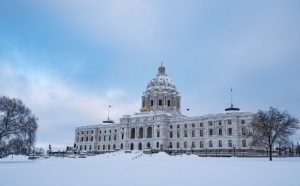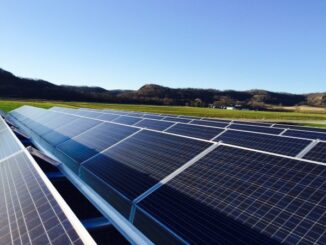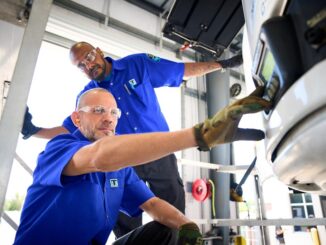
A state agency with a leading role in Minnesota’s clean energy transition is reorganizing to help the state implement its new 100% clean energy law and capitalize on a coming flood of federal spending.
The Minnesota Department of Commerce recently announced changes to its energy division, including the high-profile hire of a former U.S. Senate staffer and the elevation of two posts within the agency intended to boost energy and climate priorities.
Commerce Commissioner Grace Arnold said the moves were designed to “structure a team to meet the moment,” as the state seeks hundreds of millions of dollars in federal funding under the Inflation Reduction Act and 2021 infrastructure law.
The reorganization should also help the division support the state’s transition to clean electricity by 2040.
“I see [the reorganization] as one of a number of things that are getting us toward our goals of safe, reliable, affordable, clean energy,” Arnold said.
From railroads to renewables
The Commerce Department is the state’s oldest regulatory agency, formed in 1871 to oversee railroads before expanding over the next 150 years to include oversight of real estate, banking, consumer protection, telecommunications, utilities, insurance and other areas. Today it has roughly 370 employees and regulates more than 40 industries.
Sign up for Energy News Weekly
Get the most important energy news of the week delivered directly to your inbox.
The department’s energy division is staffed by around 90 people and includes the Conservation Improvement Program, the State Energy Office, a research center, energy and weatherization assistance and state emergency planning. Arnold said Commerce’s business units have been realigned to focus on “strategic priorities in energy and climate in an equitable way.”
Government agency reorganizations are not uncommon, but the recent changes are noteworthy, officials and outside observers say, because they better position the state to support and oversee what’s likely to be rapid changes in the state’s energy system.
The moves include:
Hiring Pete Wyckoff, U.S. Sen. Tina Smith’s former senior policy advisor for energy, climate and environment, for the new position of assistant commissioner for federal and state energy initiatives. Wyckoff will manage energy assistance, weatherization, environmental review and analysis and the state energy program. Wyckoff wrote Smith’s “Clean Electricity Performance Program” (which Democrats dropped from the final version of the Inflation Reduction Act). The Washington Post included him in a 2022 list of six Congressional staffers “who have played a big role in crafting and negotiating climate policy this year.”
Promoting Michelle Gransee, who had led the State Energy Office, to deputy commissioner of the Energy Resources Division. The division was set up to take advantage of state and federal changes that allow for substantial investment in clean energy projects in communities, businesses and homes throughout the state, with an emphasis on equity.
Promoting former energy program director Louise Miltich to assistant commissioner of regulatory analysis, overseeing regulatory issues involving the department and Public Utilities Commission, Conservation Improvement Program, energy planning, rates and telecommunications.
Hiring Lissa Pawlisch, founding director of the Clean Energy Resource Teams (CERTs), as director of the Energy Development Section. The department said Pawlisch will help accelerate equitable, affordable, resilient, and reliable clean energy deployment.
Federal money on the table
Gransee said the Inflation Reduction Act assigns Minnesota $265 million over several years for weatherization, grid resiliency, clean energy rebate programs and block grants. In addition, the state has submitted potential plans for $700 million in transmission projects, she said.
Minnesota could seek other federal grants to create a green bank and community solar for low-income rooftop projects. Gransee anticipates seeing more state legislation this session designed to take advantage of federal money, too.
“We want to pursue every potential dollar we can to come into Minnesota,” she said.
Wyckoff will lead the implementation of federal money assigned to Minnesota through the Inflation Reduction Act and seek more by applying for federal grants. He also wants to ensure Minnesotans take advantage of the act’s incentives, such as the 30% tax credit for solar projects and a $7,500 credit for electric vehicle purchases.
“The upside of tax benefits is that they will help build out Minnesota’s renewable energy sector,” Wyckoff said. Residents will benefit in other ways, such as greater access to weatherization funding and incentives for air source heat pumps and other electrification technology, he said.
The act contains several measures that will benefit rural Minnesota. Once only available to for-profit businesses and homeowners, nonprofits can now use the solar tax credit. They will receive 30% of a solar project’s cost through direct payment from the federal government.
The change allows electric cooperatives, local governments and tribes to receive money back for solar investments. “The traditional way that the feds have incentivized clean electricity is through tax incentives, but you had to in the past have a tax liability,” Wyckoff said. “Now you don’t.”
The Inflation Reduction Act includes $10 billion for rural electric cooperatives to accelerate investments in clean energy while preserving reliability. Wyckoff said he had established strong relationships with rural cooperatives during his work with Smith’s office and plans to encourage them to take advantage of the two federal bills.
Boosting climate, clean energy
Amelia Cerling Hennes, managing director of Clean Energy Economy Minnesota, a business-focused clean energy advocacy group, said energy advocates had been encouraging Commerce since Congress passed the two big legislative bills “to dig more into the climate work” by adding expertise to its staff.
“The advocacy community has been working and asking for this,” she said. “We’ve been saying the department needs more people to help to implement policies and keep track of all this federal money coming in the grant-making processes. We’re happy the department is taking these steps and making these investments.”
The department is working with state legislators to help unlock access to additional federal money. Key to the department’s efforts is the creation of a State Competitiveness Fund to provide matching funds for federal grants, technical assistance and grant writing support. Authored by North Mankato DFL Sen. Nick Frentz, the bill asks for $115 million to match grants available in both federal bills. Other states have created similar funds, but Minnesota has not and Commerce officials believe without it they cannot maximize available federal monies for energy and infrastructure projects.
One challenge is the complexity of the Inflation Reduction Act. Wyckoff said it contains 135 distinct programs, and explaining them to constituents will be left to the Commerce Department and the state’s nonprofit community.
To further prepare for the clean energy transition and the influx of federal money, the department recently unveiled a new website and assisted Clean Energy Resource Teams in developing materials for consumers seeking understandable information on the benefits of the Inflation Reduction Act.
Arnold said she plans to name replacements for Gransee and Mitlich in the coming months and may add to the Energy Resources Division roster.



